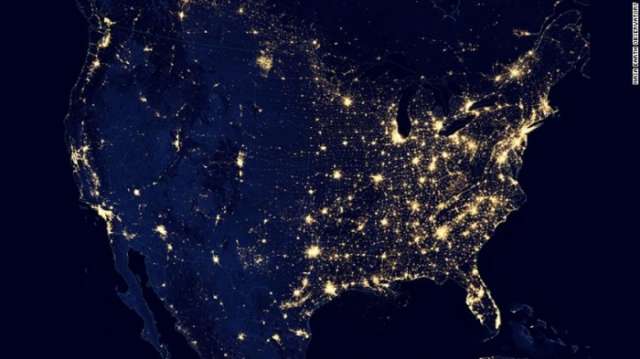Globally, there has been a push toward more energy- and cost-efficient light sources, such as LEDs, but this has directly contributed to an alarming increase in light pollution, the researchers believe.
Using the first calibrated satellite radiometer for night lights, which can detect radiance, a team of scientists found a 2.2% increase in the Earth's outdoor artificial lighting each year between 2012 and 2016.
"I was very surprised by the result of the study, particularly in wealthy well-lit countries like the US," said Christopher Kyba of the GFZ German Research Centre for Geosciences, lead author of the study.
"When we switch from a sodium lamp to a white LED, what we observe is a decrease in the total amount of light that the satellite can see. But what we saw instead for the US was basically a constant amount of light; new lights were added in other places," he said.
In many other developed countries that are already very bright, the team saw an increase in the total amount of light, despite the fact that many cities appear to be "going dark" by switching to LEDs, Kyba added.
As with the US, some of the world's brightest countries like Spain, Italy and the Netherlands showed stability in levels of outdoor light over this time frame.
The study also noted a consistent growth in lighting in South America, Africa and Asia, with a few exceptions in regions like Yemen and Syria, which showed a decrease due to escalating conflict and warfare.
The risks from light pollution
The study concluded that a steady increase in the use of energy-efficient lights that are cheap and readily available will result in even more light pollution and a reduction of natural day-night light cycles in areas that still experience them.
Light pollution poses a threat to 30% of vertebrates and more than 60% of invertebrates that are nocturnal, including plants, microorganisms and, most alarmingly, human health, the researchers add.
White LED light has been linked to disruptions in sleep patterns, and the glare is found to affect eyesight.
Last year, the American Medical Association issued an official policy statement about LED street lighting, recommending a radiance and color temperature level less harmful to health.
In August, a Harvard study found an increased risk of breast cancer in women living in neighborhoods with higher outdoor lighting. This was linked to increased brightness at nighttime, as the body expects light during daytime and darkness at night.
The health of birds is also at risk. A study published last month found that high-intensity light in urban areas can alter their behavior in terms of migration, foraging and vocal communication. The impact was especially adverse in nocturnal migrating birds that were used to orienting in darkness and were failing to do so due to light pollution.
Another landmark study published last year found that 83% of the world's population and more than 99% of the US and European populations were affected by light pollution and could not see the stars at night.
Gareth Jones, professor of biological sciences at the University of Bristol, who was not part of the new study, said it is "an important paper because it uses new and carefully calibrated methods for quantifying light pollution over a wide range of wavelengths at high spatial resolution. The study confirms that light pollution continues to increase and is of global relevance."
"Although there are benefits in terms of greater energy efficiency associated with changes to new lighting technologies such as LEDs, nevertheless light pollution and its associated risks to human health and biodiversity continue to increase," Jones added.
The Rebound Effect: How much is too much light?
The arguments for the transition to LEDs include cost-saving and reductions in energy consumption, but this has led to increased demand and greater use of outdoor lighting.
Large cities like Milan appeared to have a decrease in radiance around the city center but an increase in rural areas, which the scientists attributed to the replacement of older lamps with LEDs.
"From energy economics, there's a phenomenon called The Rebound Effect," Kyba said: If we have an energy-efficient car, for example, we allow ourselves to live farther from work and thus end up driving more. Though there's a limit to the amount of time one spends driving, with LED lights, there seems to be no saturation point.
The improved energy efficiency has therefore led to more LED lighting being installed in households and outdoors, Kyba said.
He also highlighted an issue with the way people are using LEDs, which offer features like dimmers that are going unused.
"What is currently happening is that we take take the old lamps out, keep the masts standing and get the new lamp on," he said. "So we're not using these amazing ways of using LEDs."
He also offered a practical solution to reduce the light being emitted in cities.
"In city centers, we need to completely rethink the way we light by putting people at the center and not cars, which have their own lights," Kyba said. "We shouldn't have streetlights anymore. We should have lighting for pedestrians and for the people riding bikes."
More about: #Night-Light
















































